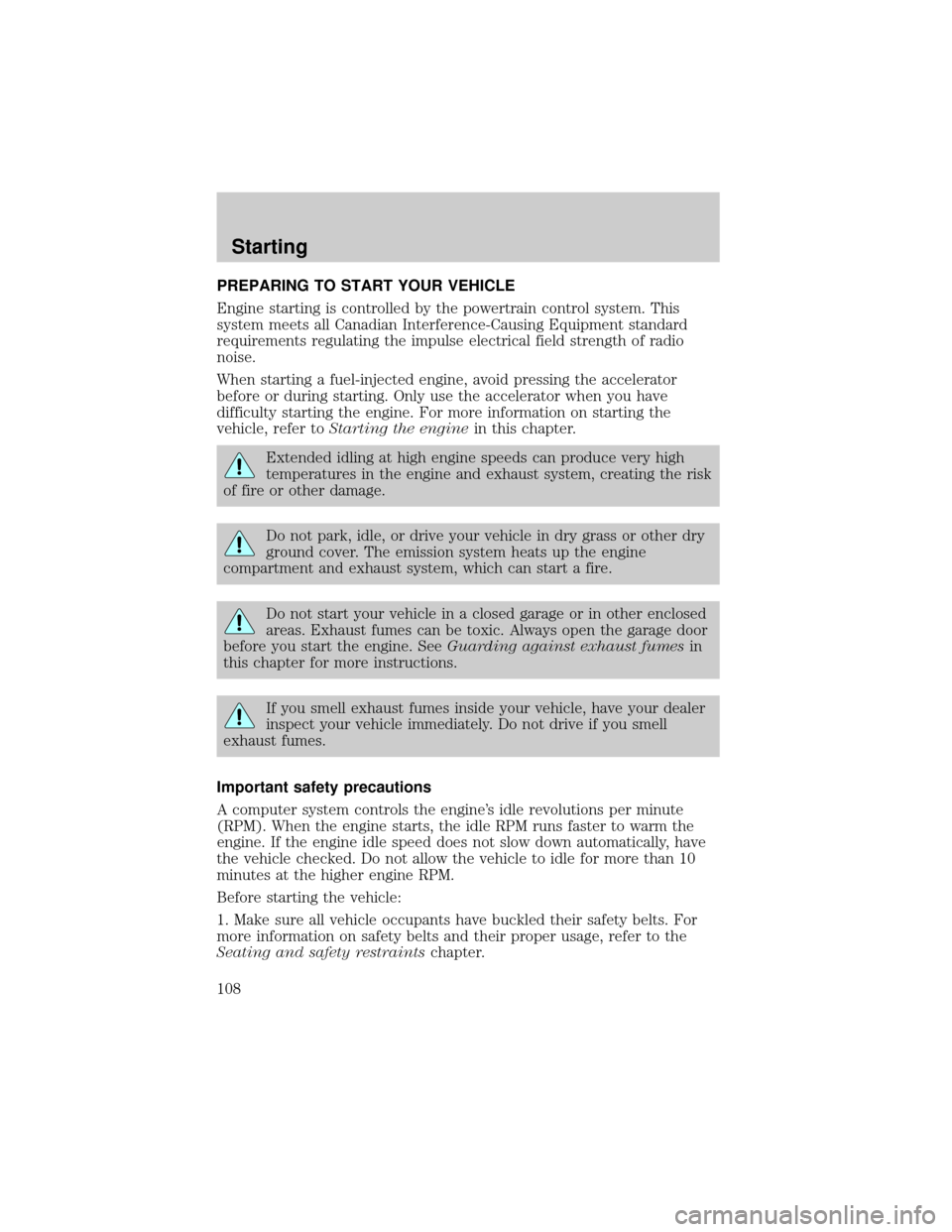2000 FORD TAURUS radio
[x] Cancel search: radioPage 42 of 232

Radio frequency information
The Federal Communications Commission (FCC) and the Canadian Radio
and Telecommunications Commission(CRTC) establish the frequencies
AM and FM stations may use for their broadcasts. Allowable frequencies
are:
AM 530, 540±1600, 1610 kHz
FM 87.7, 87.9±107.7, 107.9 MHz
Not all frequencies are used in a given area.
Radio reception factors
Three factors can affect radio reception:
²Distance/strength.The further an FM signal travels, the weaker it is.
The listenable range of the average FM station is approximately 40 km
(24 miles). This range can be affected by ªsignal modulation.º Signal
modulation is a process radio stations use to increase their
strength/volume relative to other stations.
²Terrain.Hills, mountains and tall buildings between your vehicle's
antenna and the radio station signal can cause FM reception problems.
Static can be caused on AM stations by power lines, electric fences,
traffic lights and thunderstorms. Moving away from an interfering
structure (out of its ªshadowº) returns your reception to normal.
²Station overload.Weak signals are sometimes captured by stronger
signals when you pass a broadcast tower. A stronger signal may
temporarily overtake a weaker signal and play while the weak station
frequency is displayed.
The audio system automatically switches to single channel reception if it
will improve the reception of a station normally received in stereo.
Audio system warranties and service
Refer to the ªWarranty Guideº for audio system warranty information.
If service is necessary, see your dealer or a qualified technician.
Controls and features
42
Page 43 of 232

POWER ADJUSTABLE FOOT PEDALS (IF EQUIPPED)
Press and hold the rocker control
(located on the side of the driver's
seat) to adjust accelerator and
brake pedal.
²press the rear side of the control
to adjust the pedals toward you
²press the front side of the control to adjust the pedals away from you
The adjustment allows for approximately 76mm (3 inches) of maximum
travel.
Never adjust the accelerator and brake pedal with feet on pedals
or while the vehicle is moving.
TRACTION CONTROLY(IF EQUIPPED)
This control can be used to turn the
Traction Controlyon or off. Refer
to theTraction Controlysection of
theDrivingchapter for more
information.
POSITIONS OF THE IGNITION
1. ACCESSORY, allows the electrical
accessories such as the radio to
operate while the engine is not
running.
2. LOCK, locks the steering wheel,
automatic transmission gearshift
lever and allows key removal.
3. OFF, shuts off the engine without
locking the steering wheel.
4. ON, all electrical circuits
operational. Warning lights illuminated with engine off. Key position
when driving.
5. START, cranks the engine. Release the key as soon as the engine
starts.
PEDALS
T/C O
F
F
1
23
4
5
Controls and features
43
Page 52 of 232

You will need a Phone Adapter System (PAS) that is compatible with
your cell phone that you install into the center console. This system
includes a Phone Adapter Module (PAM) with a Wiring Harness and a
Hang-Up Cup. For more information, call 1±800±736±9450 to order the
Phone Adapter System (PAS) for your specific phone.
To install the PAS, locate the four
screw holes in the console. Install
the PAM and the hang-up cup with
four screws.
Remove the connector cover and
plug the PAS wiring harness into the
harness connector in the console.
Position the PAS harness in the opening on the inside corner of the
connector cover and install the connector cover on the console.
To answer or end a call, press and
release the control button on the
microphone mounted above the rear
view mirror or use the phone itself
(refer to your phone's owner manual
for more information).
The radio will display the word
ªCALLº when you are on the phone.
Check and obey the laws and regulations on the use of wireless
telephones in the areas where you drive.
Before driving, familiarize yourself with the operation and
location of the WIM system.
To avoid potential distraction and increased risk of injury or
accident, Ford recommends you do not use the phone while
driving.
Please pull off the road and park before making or answering a call
To prevent damage to the antenna or your car, remove the cellular phone
antenna mast before using an automatic car wash.
Controls and features
52
Page 63 of 232

To program the transmitters yourself:
²Insert a key in the ignition and
turn from 3 (OFF) to 4 (ON)
eight times in rapid succession
(within 10 seconds) with the
eighth turn ending in the 4 (ON)
position. The doors will
lock/unlock to confirm that
programming mode has been
entered.
²Within 20 seconds, program a remote transmitter by pressing any
button on a transmitter. The doors will lock/unlock to confirm that the
remote transmitter has been programmed. (If more than 20 seconds
pass before pressing a remote transmitter button, the programming
mode will exit and the procedure will have to be repeated.)
²Repeat the previous step to program additional remote transmitters.
The doors will lock/unlock to confirm that each remote transmitter has
been programmed.
²When you have completed programming the remote transmitters, turn
the ignition to 3 (OFF) or wait 20 seconds. Again the doors will
lock/unlock to confirm programming has been completed.
Replacing the battery
The remote transmitter is powered by one coin type three-volt lithium
battery CR2032 or equivalent. Typical operating range will allow you to
be up to 10 meters (33 feet) away from your vehicle. A decrease in
operating range can be caused by:
²weather conditions
²nearby radio towers
²structures around the vehicle
²other vehicles parked next to the vehicle
3
4
1 2
5
Controls and features
63
Page 108 of 232

PREPARING TO START YOUR VEHICLE
Engine starting is controlled by the powertrain control system. This
system meets all Canadian Interference-Causing Equipment standard
requirements regulating the impulse electrical field strength of radio
noise.
When starting a fuel-injected engine, avoid pressing the accelerator
before or during starting. Only use the accelerator when you have
difficulty starting the engine. For more information on starting the
vehicle, refer toStarting the enginein this chapter.
Extended idling at high engine speeds can produce very high
temperatures in the engine and exhaust system, creating the risk
of fire or other damage.
Do not park, idle, or drive your vehicle in dry grass or other dry
ground cover. The emission system heats up the engine
compartment and exhaust system, which can start a fire.
Do not start your vehicle in a closed garage or in other enclosed
areas. Exhaust fumes can be toxic. Always open the garage door
before you start the engine. SeeGuarding against exhaust fumesin
this chapter for more instructions.
If you smell exhaust fumes inside your vehicle, have your dealer
inspect your vehicle immediately. Do not drive if you smell
exhaust fumes.
Important safety precautions
A computer system controls the engine's idle revolutions per minute
(RPM). When the engine starts, the idle RPM runs faster to warm the
engine. If the engine idle speed does not slow down automatically, have
the vehicle checked. Do not allow the vehicle to idle for more than 10
minutes at the higher engine RPM.
Before starting the vehicle:
1. Make sure all vehicle occupants have buckled their safety belts. For
more information on safety belts and their proper usage, refer to the
Seating and safety restraintschapter.
Starting
108
Page 222 of 232

Molded splash guards
Molded vinyl floor mats
Rear decklid spoilers
Touch-up paint
Universal floor mats
For maximum vehicle performance, keep the following information in
mind when adding accessories or equipment to your vehicle:
²When adding accessories, equipment, passengers and luggage to your
vehicle, do not exceed the total weight capacity of the vehicle or of
the front or rear axle (GVWR or GAWR as indicated on the Safety
compliance certification label). Consult your dealer for specific weight
information.
²The Federal Communications Commission (FCC) and Canadian Radio
Telecommunications Commission (CRTC) regulate the use of mobile
communications systems - such as two-way radios, telephones and
theft alarms - that are equipped with radio transmitters. Any such
equipment installed in your vehicle should comply with FCC or CRTC
regulations and should be installed only by a qualified service
technician.
²Mobile communications systems may harm the operation of your
vehicle, particularly if they are not properly designed for automotive
use or are not properly installed. When operated, such systems may
cause the engine to stumble or stall. In addition, such systems may be
damaged or their performance may be affected by operating your
vehicle. (Citizens band [CB] transceivers, garage door openers and
other transmitters with outputs of five watts or less will not ordinarily
affect your vehicle's operation.)
²Ford cannot assume responsibility for any adverse effects or damage
that may result from the use of such equipment.
Customer assistance
222
Page 225 of 232

Accessory delay ..........................54
Air bag supplemental
restraint system ................94,95,98
and child safety seats ..............96
description ...........................95,98
disposal ....................................100
driver air bag ..................94,97,99
indicator light ......................12,97
operation .........................94,97,99
passenger air bag ...........94,97,99
side air bag ................................98
Air cleaner filter .......................205
Air conditioning ..........................18
automatic temperature
control system ..........................21
Air filter, cabin ..........................166
Antifreeze
(see Engine coolant) ................157
Anti-lock brake system
(see Brakes) .......................113,114
Anti-theft system ........................64
arming the system ....................64
disarming a triggered system ..66
warning light .............................11
Audio system (see Radio) .........28
Automatic transaxle .................118
driving with .............................120
fluid, adding ............................163
fluid, checking ........................163
fluid, refill capacities ..............206
fluid, specification ..................208
Auxiliary power point .................27
Axle
lubricant specifications ..........207
Battery .......................................171
acid, treating emergencies .....171
charging system
warning light .............................12
jumping a disabled battery ....142
maintenance-free ....................171
replacement, specifications ...205
servicing ..................................171Belt minder .................................90
Brakes ........................................113
anti-lock ............................113,114
anti-lock brake system
(ABS) warning light ..........11,114
brake warning light ..................12
fluid, checking and adding ....155
fluid, refill capacities ..............206
fluid, specifications ..........207,208
lubricant specifications ...207,208
parking ....................................115
pedals (see Power
adjustable foot pedals) ............43
shift interlock ..........................118
Break-in period .............................3
Capacities for refilling fluids ....206
Cargo area shade ........................59
Cargo cover .................................58
Cargo net .....................................58
CD changer .................................38
Cellular telephone
Wireless Interface Module .......51
Certification Label ....................210
Child safety restraints ..............101
child safety belts ....................101
Child safety seats ......................102
attaching with tether straps ..106
in front seat ............................103
in rear seat .......................103,106
Cleaning your vehicle ...............198
engine compartment ..............201
exterior ....................................200
exterior lamps .........................200
instrument panel ....................203
instrument panel lens ............203
interior ..............................203,204
mirrors .....................................200
plastic parts ............................200
safety belts ..............................203
washing ....................................199
waxing .....................................199
wheels ......................................200
Index
225
Page 228 of 232

brake ..........................................12
charging system ........................12
check coolant ............................11
cruise indicator .........................11
door ajar ......................................9
high beam ...................................8
low coolant ................................10
low fuel ......................................10
oil pressure ...............................12
safety belt ...................................9
service engine soon ....................9
speed control ............................46
traction control active ................8
turn signal indicator ...................8
Load limits .................................123
GAWR ......................................123
GVWR ......................................123
trailer towing ..........................123
Locks
autolock .....................................69
childproof ..................................54
Lubricant specifications ....207,208
Lumbar support, seats ...............76
Mirrors .........................................51
cleaning ...................................200
heated ........................................55
side view mirrors (power) .......55
Moon roof ....................................51
Motorcraft parts .................184,205
Octane rating ............................182
Odometer .....................................15
Oil (see Engine oil) ..................152
Overdrive ...................................119
Panic alarm feature, remote
entry system ................................61
Parking brake ............................115
Parts (see Motorcraft parts) ....205
Pedals (see Power adjustable
foot pedals) .................................43
Power adjustable foot pedals .....43
Power distribution box
(see Fuses) ...............................136Power door locks ........................54
Power steering ..........................117
fluid, checking and adding ....162
fluid, refill capacity ................206
fluid, specifications ..........207,208
Radio ............................................28
Relays .................................133,138
Remote entry system ............60,61
illuminated entry ......................62
locking/unlocking doors ......60,61
opening the trunk .....................61
panic alarm ...............................61
replacement/additional
transmitters ...............................62
replacing the batteries .............63
Roof rack ...................................129
Safety belts
(see Safety restraints) .....13,78,80
81,82,83,84,86
Safety defects, reporting ..........224
Safety restraints ......78,80,81,82,83
84,85,86,88
belt minder ...............................90
cleaning the safety belts ...93,203
extension assembly ..................89
for adults ....................81,82,83,84
for children ......................100,101
lap belt ......................................87
warning light and chime ..9,13,89
Safety seats for children ..........102
Seat belts
(see Safety restraints) ...............78
Seats ............................................74
child safety seats ....................102
cleaning ............................203,204
SecuriLock passive
anti-theft system ....................70,71
Servicing your vehicle ..............148
Spark plugs,
specifications ......................205,208
Specification chart,
lubricants ............................207,208
Index
228